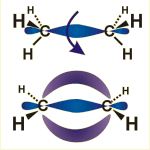 Double bonds
Double bonds
The graphical model shows the distribution of electrons in the case of a single bond (above) and of a double bond (below). (In both cases, only the bond between the two carbon atoms is detailed. The hydrogen atoms bound to the carbon atoms are given as symbols.)
The additional electrons of a double bond are situated above and below the electrons of a single bond. Therefore this additional bond is not as strong as a second single bond. In addition, the two partners can no longer rotate freely against each other (as in the case of single bonds), resulting in cis-trans isomery. The other groups bound to carbon atoms participating in double bonds are lying within one common plain separated by angles of 120 degrees.